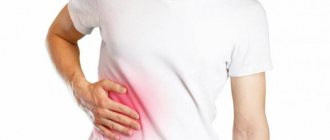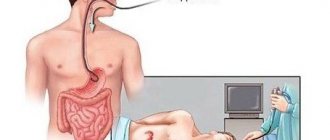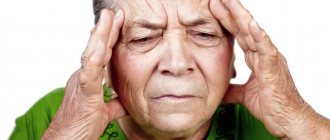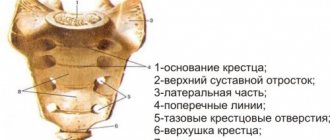What is under the right rib?
In order to determine what is located under a person’s ribs on the right side, let us turn to topographic anatomy.
The right hypochondrium is part of the anterior abdominal wall, which is limited by:
- at the top – projection of the diaphragm (fifth rib);
- below – the lower edge of the arch of the ribs;
- inside - a line passing vertically through the point of the ribs is at the very bottom;
- outside - a line running vertically from the upper protruding pelvic bone (iliac crest).
If we extend the lower border of this area onto the back, we will see that it runs along the 12th rib and the third lumbar vertebra.
You can find out where the right hypochondrium is located in this way: place the palm of your right hand horizontally on the ribs so that the wrist is in the middle of the side, while the edge of the little finger should coincide with the edge of the ribs from below. If we leave the wrist in the same position and clasp the palm of the back, we get a posterior projection of the right hypochondrium.
In this area, pain may occur due to damage to the following organs:
- gallbladder, liver;
- right kidney (upper part);
- large intestine (part of it is the flexure of the colon);
- peritoneal part of the right half of the diaphragm;
- adrenal.
Along with this, in this area, tingling and pain can be reflected from the duodenum, pancreas, inferior vena cava, and bile ducts.
Appendix
Here is another organ located on the right under the ribs in front. More precisely, the appendix is an appendage of the cecum and, of course, is still located much lower than the ribs. It is located in the right iliac region and has a narrow cavity. It opens into the cecum with a hole that is surrounded by a valve - a small fold of mucous membrane. Interestingly, with age, this gap closes up in some people - completely or partially.
What function does this vermiform appendix perform? Protective. The accumulations of lymphoid tissue present in it constitute the peripheral parts of the immune system. And in herbivores, for example, the microflora present in the appendix is involved in the process of digesting cellulose.
Answering the question: “What is on the right side of a person under the ribs?”, we must make a reservation that for people with a removed appendix, it is much more difficult to restore the intestinal microflora if there has been any infection.
In fact, this process is a repository for bacteria. What is contained in the intestines does not get into it, and therefore the appendix is a good environment for the proliferation of beneficial bacteria. It is also an incubator for E. coli.
The appendix plays, one might say, a saving role in preserving the original microflora of the colon. It contains conglomerates of lymphoid follicles, and the organ itself functions as a unified mucosal immune system.
But, as everyone knows, many people have their appendix removed. Why? The indication for this operation is chronic and acute appendicitis, manifested in inflammation of the appendix.
Pain in the right hypochondrium in healthy people, why does it occur?
Sometimes discomfort and nagging pain on the side, behind, as well as pain on the right under the ribs in front can be felt even by a completely healthy person. Such manifestations are associated with certain physiological conditions.
Physical exercise
Pain may appear during the process and as a result of physical activity.
People who are not accustomed to subjecting themselves to strenuous physical activity may notice, after heavy work or sports, that they have severe stabbing pain in the right side under the ribs in front.
The reason for such manifestations is associated with the following process: when adrenaline is released, the tone of the bile ducts decreases, and they are stretched by stagnant bile. Meanwhile, the liver is actively filling with blood, its capsule is stretching, and tingling occurs. There may even be acute pain from the back and front.
Pain after eating, especially a heavy meal, almost always appears in the hypochondrium during physical activity. If it hurts in the right side under the ribs in front, please note that after eating it is especially not recommended to run or do push-ups.
In addition, it is known that it can cause dull pain in the right hypochondrium in front and spasm of the diaphragm. A person feels it when he sighs, sometimes when he inhales and exhales. The same sensations can occur when coughing. But such pain is usually short-lived. Sometimes it becomes dull when pressed. As a rule, if breathing evens out after exercise, this symptom disappears.
However, explanations for why the ribs on the right side hurt are not always true. Sometimes why aching pain appears during exercise, some sources explain the expansion of the inferior vena cava due to the influence of adrenaline and its pressure on the liver.
Before determining what hurts in the right side under the rib, you should take into account that under the influence of adrenaline, vasoconstriction occurs, and there are no pain receptors in the liver.
Pain in women: hormonal imbalance and pregnancy
In the last days of the monthly cycle, a certain proportion of women may develop a sharp hormonal imbalance. As a result, a spasm of the biliary tract develops, and a sharp pain appears, radiating to the back in some cases. Therefore, the explanation for what hurts in the right hypochondrium is sometimes precisely the characteristics of the female body.
In some cases, premenstrual syndrome worsens when taking hormonal contraceptives. In this case, both stabbing and dull pain, as well as burning, appear due to a violation of the passage of bile.
During pregnancy, pain under the right rib in the front is explained by the physiology of the expectant mother’s body.
As you know, during late pregnancy the uterus stretches incredibly. It puts pressure on nearby organs. Therefore, healthy women who experience stabbing in the right side during pregnancy, and also develop numbness in this area, should not worry about why stabbing in the right side during pregnancy.
Consider the fact that the hormone progesterone promotes dilation of the bile ducts and stagnation of bile. It is also very common for pregnant women to experience colitis in the side when running or other activities. Therefore, you should limit yourself to active walks in fresh air at an easy pace.
It hurts in front under the ribs on the right, what could it be?
A common symptom is pain on the right side under the ribs. This can be caused by various diseases or problems .
Even completely healthy people can experience soreness in this area. There are many internal organs located on the right under the ribs, so the list of diseases will be large.
First of all, you need to figure out what kind of pain should cause a person’s anxiety.
Pain varies
In adolescents, pain on the right side is considered normal, as it indicates the development of the body and its growth. Such manifestations also occur when:
- certain physical activities, for example, walking, running;
- taking certain hormonal medications;
- pregnancy;
- premenstrual syndrome.
Duration less than 30 minutes is considered short. The concern should be caused by pain that does not go away for more than an hour, intensifies with movement, and has a stabbing, sharp character.
Ask your question to a neurologist for free Irina Martynova. Graduated from Voronezh State Medical University named after. N.N. Burdenko. Clinical resident and neurologist BUZ VO \"Moscow Polyclinic\".Ask a question>>
It is the acute nature of the pain that is often associated with inflammation of the appendix. Stitching unbearable pain is a sign of rupture of the liver, gall bladder, or kidney. Acute pain, which intensifies when walking, gives reason to assume the presence of a hematoma in the internal organs.
A dull pain, similar to the heaviness of a bag hanging on its side, signals chronic pathologies of the internal organs (pancreatitis, malignant neoplasm, cirrhosis of the liver).
Sometimes the pain is of a mixed nature. It is tugging, dull, but at times sharp. Wandering, short-term under the rib on the right or spreads so that it is difficult to determine its location. Such manifestations have psychosomatic causes; it is necessary to contact a neurologist.
Expert opinion
Filimoshin Oleg Alexandrovich
Neurologist, city clinic of Orenburg. Education: Orenburg State Medical Academy, Orenburg.
The manifestations of diseases are similar; they are easy to confuse. You need to know the characteristics of pathologies in order to distinguish one from another.
Be sure to watch the next video
Localization of pain
The nature of the discomfort depending on the possible diagnosis:
- Inflammation of the gallbladder, myocardial infarction - pain is acute, sharp, squeezing in the right hypochondrium.
- Lactose deficiency, overeating - short-term, aching pain in the middle of the abdomen.
- Gastritis, gastric ulcer, gastroduodenitis - the nature of the pain syndrome in the epigastrium is varied: cutting or stabbing, dull or sharp, bursting or aching.
- Appendicitis - an acute, dull pain in the right lower abdomen that radiates to the rectum area, when trying to take a horizontal position, that is, lie on the left side, and also intensifies when walking.
- Gynecological diseases in acute or chronic form - intermittent, sharp, sudden, nagging pain in the lower abdomen.
If the patient cannot differentiate his perception of pain by the exact location, it will be difficult for the doctor to make a diagnosis. Often patients who do not know how to “listen” to themselves confuse these pain sensations in the right side under the ribs with symptoms of osteochondrosis.
To make a correct diagnosis, the patient needs to accurately determine the place where the pain is felt. Many people take pain in the right hypochondrium on the side with symptoms of osteochondrosis.
- Gallbladder:
- Parasites (giardia, opisthorchiasis)
- Cholelithiasis
- Pancreas:
- Cancer (late stage)
- Liver:
- Cirrhosis
- Parasitic infestations (amoebiasis, giardiasis, opisthorchiasis,)
- Stagnation of blood due to heart failure, resulting in stretching of its membrane
- Intestines
- Diaphragm:
Most often this is associated with pathology of the right kidney - pyelonephritis (chronic or acute).
- In acute pyelonephritis, intense dull pain is observed in the lumbar region. With this disease, pain increases from tapping on the lower rib located behind
- Chronic pyelonephritis causes mild, aching pain that worsens in cool and damp weather.
Hepatitis
This is a liver disease. You can become infected through a blood transfusion, through a sexual partner, when applying a tattoo with unsterile needles, or through acupuncture.
Signs of infection
- heat;
- pain on the right under the ribs;
- dark urine;
- aches throughout the body;
- discolored stool;
- possible skin rashes.
Nature of pain
The pain under the ribs has a bursting, aching character , because the liver has enlarged and puts pressure on other internal organs and ribs.
Source: https://pol5.ru/zabolevaniya/bolit-pravoe-rebro.html
Causes of pain in the right hypochondrium
The reasons why a person has a stabbing sensation in the right side under the ribs in front can be associated with a number of different reasons. Only a specialist can determine exactly why it stings under the ribs and aches in the side. But the causes of pain may be associated with the following diseases and conditions:
- a number of liver diseases (causes of pain in the liver - infectious and non-infectious hepatitis, hepatosis as a result of alcohol consumption, fatty hepatosis, cirrhosis, hepatocellular cancer, diseases caused by parasites, metastases in the liver as a result of cancer of the colon, stomach, breast, etc. .);
- heart diseases in which there is circulatory failure in a large circle (myocardiopathy, ischemic heart disease, myocarditis, endocarditis, heart defects), also abdominal variant of myocardial infarction, cardiac cirrhosis of the liver;
- gallbladder diseases (cholecystitis, tumors);
- diseases of the colon (colitis, Crohn's disease, dysbiosis, diverticulosis, intestinal infections, colon tumors, irritable bowel syndrome);
- diseases of the right kidney (kidney abscess, pyelonephritis, polycystic disease, urolithiasis, tumors, echinococcosis, kidney tuberculosis, metastases from bronchogenic cancer, melanoma);
- pathological changes in the right half of the diaphragm (tumors, diaphragmatitis);
- diseases of the right adrenal gland (tumors);
- intercostal neuralgia;
- fractures of the lower ribs;
- shingles;
- conditions in surgery, which are united by the name “acute abdomen” (acute pancreatitis, duodenal bleeding, penetration, perforation or perforation of an ulcer, intestinal obstruction, appendicitis, intussusception, etc.);
- thrombosis of the inferior vena cava (some variants).
When does the front right side hurt?
Tingling or sharp pain in the right side occurs due to diseases of the organs that are adjacent to this area. Some conditions are accompanied by pain from the back, sometimes it radiates to the leg, shoulder blade, kidney, etc. There may also be pain in the lungs when taking a deep breath.
With some diagnoses, pain may be periodic, appearing when walking or coughing. With others, unpleasant sensations bother you constantly.
Liver diseases
As a rule, a dull pain appears in the right side, sometimes the dull pain can be replaced by a bursting pain. Sometimes the discomfort is associated with a feeling of heaviness due to blood filling and swelling of the liver. Something bothers the patient and constant discomfort manifests itself.
If the liver hurts, the reasons for this phenomenon may be associated with stretching of the capsule in which this organ is located. A burning sensation in the liver area is sometimes accompanied by pain radiating to the back, shoulder, and neck. Distention, heaviness and nausea may not disappear throughout the day. Sometimes liver dysfunction occurs due to poisoning, alcohol intoxication, etc.
Hepatitis. If a patient develops hepatitis of any origin, then, first of all, the patient experiences intoxication and dyspepsia. That is, a person feels nauseous, has bloating, pain in the abdominal area, especially after eating. Sometimes it tingles in the right side. In this case, the color of a person’s urine and feces changes, the whites in the eye turn yellow, and jaundice develops.
Cirrhosis of the liver. In patients with cirrhosis, liver cell death and changes in its structure are observed. People with this diagnosis have pain in the right side at the waist level, sometimes the pain is felt in the back.
With cirrhosis, a person may notice pain in the right side below the ribs, already at the very beginning of the disease. At the same time, the burning sensation in the right side is persistent.
In the later stages of cirrhosis, the liver becomes smaller, its performance decreases, the patient develops hepatic coma, and death is likely.
Echinococcosis. The disease is provoked by the worm Echinococcus; as the disease develops, a person develops cysts with fluid inside. As a rule, they form in the right lobe of the liver and gradually compress the bile ducts and capillaries. These are the causes of liver enlargement and pain. Initially, heaviness and discomfort appear in the right side below the ribs. If the cyst ruptures, a liver abscess develops. In this case, there is a sharp pain in the right side. A sharp throbbing pain disturbs when walking, when moving, and radiates to the back. The temperature also rises, and the development of inflammation of the peritoneum and blood poisoning is likely.
Congestive heart failure
Why discomfort in the right hypochondrium in this case is bothersome is explained by the patient’s condition. Initially, his blood circulation deteriorates, as a result, the liver enlarges, and fluid accumulates in the abdominal cavity. A nagging pain appears in the right side, a feeling of heaviness. A nagging pain is disturbing as the disease progresses.
With abdominal myocardial infarction, the patient experiences severe, burning pain in the lower right hypochondrium. Sometimes the patient complains that there is pressure in the side. But in some cases, the onset of pain is sometimes very sharp, similar to the blow of a knife; the pain appears in the shoulder blade and sternum. As a rule, this happens with the development of infarctions of the posterior wall of the heart muscle. Sometimes it seems to the patient that this painful sensation manifests itself in waves: periodically it decreases and intensifies. In this case, pallor, heart rate disturbances, and a drop in pressure may be noted.
Gallbladder disease and flank pain
In such diseases, accompanied by an inflammatory process, stabbing pain in the right side behind appears most often.
Stitching pain in the hypochondrium and in the back develops when a stone has moved and blocked the bile duct. It also develops with acute inflammation - in this case, it hurts in the place between the rectus abdominis muscle and the costal arch on the right. Such pains are cramping and radiate to other places - they appear in the shoulder, in the left hypochondrium. There is also an increase in temperature, vomiting, and belching.
But if the patient has already had his gallbladder removed, but discomfort continues to manifest itself, a natural question arises: what could hurt in the right side under the rib?
If a person does not have a gallbladder, the cause of pain may be the so-called syndrome after cholecystectomy, that is, an exacerbation of other ailments, for example, inflammation of the biliary tract, liver disease, etc. Such patients often note that the side on the right side hurts after eating. This may be due to eating cold food, large amounts of food, fatty, spicy foods, or coffee.
The reasons why aching pain develops in the right side may be associated with chronic cholecystitis. Such patients are worried about dull aching pain in the lower back, nausea, and loss of appetite. There is bloating, bitterness in the mouth, and a headache. Chronic diseases often worsen during pregnancy.
Colon diseases
The answer to the question why the right side of the back hurts and colic appears in the lower abdomen may be associated with diseases of the colon.
The more the colon stretches, the more severe the colic appears. The pain remains less pronounced until the peritoneum is involved in the inflammatory process.
It should be taken into account that in a person’s right side, under the ribs, there is a bend of the colon, that is, only part of the intestine. Therefore, the pain spreads to the entire area around the navel and to the entire right side up to the groin.
It is necessary to take into account, if the right side hurts, that it could also be colitis, which mainly causes spastic pain, stool disturbances, and flatulence.
With nonspecific ulcerative colitis and Crohn's disease, spasmodic pain develops not only in the hypochondrium, but also in all lower abdomen. At the same time, bloating is also noted. People with this diagnosis may develop bleeding, mucus and pus are detected in the stool, the condition is sometimes complicated by intestinal obstruction and intestinal necrosis.
In the case of tumor development, intestinal obstruction is most often observed, there is a picture of an acute abdomen, signs of peritoneal irritation, pressure drops, pallor and cold sweat are observed.
During an attack of appendicitis, pain begins to develop in the epigastrium, after which it gradually spreads to the right hypochondrium and descends to the iliac region on the right.
When is it necessary to seek help from a doctor?
Acute, cramping, burning or throbbing pain on the right side of the abdomen or right side can indicate a large number of diseases. Therefore, when pain appears in the area of the right hypochondrium, you also need to focus on secondary symptoms. Nausea, nausea, feeling as if sick and very nauseous, the urge to vomit with severe pain in the right side, single or repeated vomiting, all of these can be symptoms of intoxication, food poisoning, diseases of the biliary tract, gall bladder or liver. Very severe pain in the area of the right side of the abdomen with high body temperature, if there is diarrhea (diarrhea), frequent and loose stools (diarrhea with blood, mucus, discolored stool during diarrhea, pus in the stool), dehydration or severe and paroxysmal pain.
If you suddenly start to feel pain in the right side of your abdomen, lower abdomen, or aching or nagging pain below your waist, these may be symptoms of inflammation of the appendix. With appendicitis, pain can first be felt in the front or center of the abdomen, radiate to the tailbone, groin area, pain can radiate to the lower back, when the pain is felt more from the back. But in the end, in most cases, sharp, pulling, aching, sharp or severe cramping pain is felt in the right lower abdomen (next to the intestines on the right side). If the first symptoms and signs of appendicitis are detected, it is recommended to call emergency medical care, because Untimely treatment of the appendix can threaten not only health, but also human life.
Manifestation of pain in the right hypochondrium behind
When a patient complains that there is pain in the back under the right shoulder blade, the reasons for this may be associated with injuries to the lower ribs or damage to the intercostal nerves. Pain appears from behind under the right shoulder blade from the back and with lesions of the right kidney and adrenal gland. The causes of back pain may also be associated with diseases of the inferior vena cava.
Urolithiasis disease
Burning and severe pain can bother people with urolithiasis. When moving, stones or sand scratch the renal pelvis, and later the ureter. Consequently, with renal colic there is pain in both the lateral abdomen and the lower back. Painful attacks are observed, spasms radiate to the genitals, to the thigh, and is felt in the groin. If you hit the lower back a little with the edge of your palm, it hurts even more, and blood may appear in the urine. Sometimes vomiting occurs.
Pyelonephritis
The development of acute infectious inflammation of the kidney is accompanied by pain in the kidney area, intoxication, and fever. It also hurts when urinating, periodic false urges are noted, and swelling appears on the face.
With apostematous pyelonephritis, purulent inflammation develops in the kidneys. I am concerned about prolonged nagging pain, the temperature increases, and the amount of urine excreted per day decreases.
Necrosis of the renal papillae
This phenomenon becomes a consequence of oxygen starvation of the kidney tissue if the vessels become clogged. Constant pain is accompanied by the appearance of blood in the urine. There is a possibility of death from septic shock.
Acute upper paranephritis
The inflammatory process of fatty tissue in the area of the upper part of the kidney manifests itself as a consequence of infection from carious teeth, tonsils, etc. First, the patient’s temperature rises and there is moderate pain in the lower back. After a few days, there is already pain in the right hypochondrium, the pain intensifies with a deep sigh, the condition worsens and physical efforts - pain is noted when moving, walking, sharply straightening the body.
Kidney cancer
This condition may not appear for a long time. Mild pain and bleeding appear already in the last stages of the disease. Sometimes the tumor interferes with the outflow of urine, then acute pain is noted.
Pain in the hypochondrium also occurs with tumors of the right adrenal gland, provided that the tumor is large.
Intercostal neuralgia
The reason that a person’s right side feels tight and numb in the hypochondrium area may be intercostal neuralgia. In this state, sometimes there is a pulling from the back, the ribs hurt on both sides in front. With neuralgia, there is a strong tingling sensation in different areas, even to the point of limited mobility. The pain becomes stronger when bending or turning. Also, the cause of a sudden tingling sensation in the pit of the stomach or twitching on both sides can be myositis, when a person’s muscles are inflamed.
Bruised ribs
Severe aching pain, aggravated by coughing, pressing, bending, sighing, occurs with bruises of the posterior segments of the ribs. When rib fractures occur, a characteristic crunch is felt.
Osteochondrosis of the lumbar region
If there is muscle tightness, limited mobility, signs of tension, pain in the right shoulder, in the arm, then the causes of this condition may be associated with osteochondrosis of the lumbar region. Painful sensations can have different intensities, be both aching and shooting in nature, and appear above and below.
Shingles
In this case, herpetic eruptions appear along the nerve in the form of bubbles with cloudy liquid, and the skin turns red. Itching, burning, and pain develop at the site of the lesion. This means that you need to see a dermatologist.
Vena cava thrombosis
If a blood clot comes from the iliac veins, after which it clogs the vein trunk, pain occurs in the lower back on the right side of the back. The clinical picture is similar to that of a late-stage kidney tumor. If thrombosis of the liver segment occurs, intense bursting pain occurs in the front in the right hypochondrium and radiates under the scapula on the right. Jaundice also develops and fluid accumulates in the abdominal cavity.
The pain is acute
The sensation of acute pain in the right lobe of the hypochondrium is associated with the development of acute surgical conditions - the so-called “acute abdomen”. In particular, severe pain is observed in the following diseases and conditions:
- damaged internal organs (injury to the kidney, colon, kidney, damage to the gallbladder, hematoma of the kidney, liver);
- intestinal perforation, diverticulum ruptures;
- acute inflammatory processes of the gallbladder, acute pancreatitis;
- initial stage of appendicitis;
- blockage of the bile ducts, intestinal obstruction;
- thrombosis of the veins and arteries through which nutrition of internal organs occurs.
In such conditions, very intense pain develops, which leads to the development of painful shock, loss of consciousness, decreased blood pressure, and disruption of the functioning of internal organs.
With an acute abdomen, the abdominal muscles are tense, sometimes the pain is girdling, sometimes it’s pinpoint pain, but very often it’s unbearable.
Acute, compressive pain also occurs in the abdominal form of myocardial infarction, renal colic, and sometimes in nonspecific ulcerative colitis and rib fractures.
Useful video
The video will tell you useful information about the structure and function of the liver:
If you look at the diagram of the location of organs in the body, you can see that on the right side in the area under the ribs there are:
- liver,
- gallbladder,
- duodenum,
- colon.
Problems with these organs can manifest as pain in the right side. But not only them. Diseases of the pancreas, appendicitis, genitourinary system, and spine can also cause pain in this place.
| Pain in the right side under the ribs is a nonspecific sign. |
It cannot diagnose the problem. But this is often very dangerous, since this area contains several important organs, disruption of which poses a serious danger.
Let's figure out what diseases it can signal.
Dull pain
Dull pain very often indicates the development of an inflammatory process. They manifest themselves in the following pathologies:
- hepatitis in acute and chronic form;
- liver cancer, cirrhosis, parasitic lesions of the right lobe of the liver;
- period between exacerbations of cholecystitis, cholangitis;
- adrenal tumors;
- intestinal diverticulosis, colitis;
- hydronephrosis, pyelonephritis, late stage of kidney tumors, apostematous nephritis.
In the iliac region there is constant pain due to tumors, metastases of internal organs, rib fractures, and parasitic liver cysts.
Heaviness in the right side
Heaviness in the right side and lower abdomen, as well as in the upper abdomen, develops with various diseases. Often, heaviness in the right side under the ribs in front develops with an edematous liver. In addition, the causes of heaviness in the right hypochondrium may be associated with the development of hepatitis, fatty hepatosis, chronic cholecystitis, and hypomotor biliary dyskinesia.
After meal
Many people note that they have a tingling sensation in their right side after eating, heaviness in the epigastrium and rumbling develop. Often expectant mothers are also interested in why it hurts in the right side during pregnancy.
After eating food, the process of secretion and movement of bile in the body accelerates, the liver fills with blood, and peristalsis is activated. Therefore, with chronic diseases of the liver, intestines, and gall bladder, pain in the lower and upper abdomen often appears after eating.
Such manifestations can have a different character: a person feels sick, belches, diarrhea, constipation, and his stomach growls.
Dull pain after eating is observed with cholecystitis, sharp pain with colitis and dysbacteriosis, stabbing pain with cholelithiasis and biliary dyskinesia. Often the pain becomes more intense after heavy drinking or heavy smoking.
After load
Unpleasant sensations in the form of nagging or stabbing pain occur after physical exertion in people with hepatitis, cirrhosis, or congestive liver. After shaking or physical exertion, an attack of calculous cholecystitis may occur.
Also, periodic pain during exercise appears in patients with myositis, intercostal neuralgia, osteochondrosis, rib fractures, and vena cava thrombosis.
Digestive system problems
It was previously mentioned that it is located under a person’s right hypochondrium, and it is logical to assume that the cause of the pain may be some pathology of the gastrointestinal tract. And if this is really the case, then in addition to this symptom, a person is also worried about diarrhea, bloating, “sour” belching, as well as nausea, heartburn and a metallic taste in the mouth.
And here are the problems that may arise in such cases:
- Pancreatitis. It manifests itself in inflammation that affects the pancreas. A person is bothered by vomiting and a feeling of fullness in the stomach, there is flatulence and active “rumbling”.
- Gastritis. With this disease, pain from the hypochondrium radiates to the lower back. Additional symptoms include abdominal swelling and bad breath.
- Cholecystitis. When the gallbladder is inflamed, the pain in the hypochondrium is dull and aching in nature. It is often accompanied by tingling localized in the abdominal area.
- Appendicitis. Characteristic symptoms are a sharp loss of strength, nausea with severe vomiting, high fever and unbearable pain in the right hypochondrium. In a person, organs in this state seem to acquire increased sensitivity - the sensations are so pronounced. It is not surprising that people with appendicitis are immediately hospitalized.
- Pathologies of the colon. These include ulcerative colitis, Crohn's disease, intestinal infections and disturbed microflora, as well as diverticulosis and irritation.
- Bowel perforation. This condition is characterized by the presence of a through hole in the large intestine through which all food enters the abdominal cavity.
There is one more reason that is worth noting when discussing the features of human anatomy. In the right hypochondrium, pain often occurs after physical activity. If they appear consistently, then the reason lies in biliary dyskinesia. Usually this pathology resolves on its own after some time.











